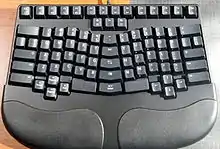Ergonomic keyboard
An ergonomic keyboard is a computer keyboard designed with ergonomic considerations to minimize muscle strain, fatigue, and other problems.[1] Ergonomic keyboards for two-handed typists are typically constructed in a V shape, allowing the hands to rest at a more natural angle.

Types


Split keyboard
Split keyboards group keys into two or more sections. Ergonomic split keyboards can be fixed, where you cannot change the positions of the sections, or adjustable. Split keyboards typically change the angle of each section, and the distance between them. On an adjustable split keyboard, this can be tailored exactly to the user.
Contoured keyboard

A further development of the split concept are contoured keyboards like the 1977 Maltron or the newer Kinesis Advantage line, which place the keys into two depressions set approximately at shoulder width, with function keys set between the key groups for use with the thumbs. In this configuration, very little movement of arms and wrists is required.
Handheld keyboards
Handheld ergonomic keyboards are designed to be held like a game controller, and can be used as such, instead of laid out flat on top of a table surface. They allow the user the ability to move around a room or to lean back on a chair while also being able to type in front or away from the computer.[2] Some variations of handheld ergonomic keyboards also include a trackball mouse that allow mouse movement and typing included in one handheld device.[3]
Angle split keyboard
The angled split keyboard (sometimes referred to as a Klockenburg keyboard) is similar to a split keyboard, but the middle is tented up so that the index fingers are higher than the little fingers while typing. Key Ovation makes the Goldtouch ergonomic keyboard which is an adjustable angled split keyboard.
Other ergonomic keyboards
Other ergonomic keyboards have fixed, vertically aligned keys, so the user types with their hands perpendicular to the ground, thumbs-up. Still others allow a range of rotation and elevations. A few ergonomic keyboards do not have the typical one key per letter, such as a keyer or a keyless ergonomic keyboard.[4] DataHand eliminates the need for any wrist motion or finger extension.
Considerations
It is widely claimed that an ergonomic keyboard may reduce muscle strain and reduce risk of carpal tunnel syndrome or other kinds of repetitive strain injury.[5][6][7][8] With respect to "split" keyboards, quality studies that demonstrate injury reductions are lacking, with the exception of physically split keyboards which have "sharply angled keyboard faces". There is evidence, however, that such keyboards are not well tolerated.[9]
Narrow studies examining hand position at rest neglects many other possible factors. For example, one should be aware that the effect of “ergonomic” keyboards is to change the musculoskeletal region exposed to risk, instead of eliminating hazardous postures.[10]
See also
References
- Michelle Manalo (April 5, 2007). "Blueprint for a healthy workstation". The Calgary Herald. Archived from the original on 2007-11-19. Retrieved 2007-04-20.
- "The World's Most Comfortable Computing Keyboard". AlphaGrip Comfortable Hi-Speed Gaming and Computing. AlphaGrip, Inc. Retrieved 2015-02-24.
- "Handheld Hi-Speed Text Entry Will Power True "Anywhere Computing"". AlphaGrip Comfortable Hi-Speed Gaming and Computing. AlphaGrip, Inc. Retrieved 2015-02-24.
- orbiTouch keyless ergonomic keyboard
- Hobday, Stephen (September 1985). "KEYBOARDS DESIGNED TO FIT HANDS & REDUCE POSTURAL STRESS". Paper presented by S.W. HOBDAY at the NINTH CONGRESS OF THE INTERNATIONAL ERGONOMICS ASSOCIATIONS, 2–6 September 1985, Bournemouth, England. PCD Maltron Ltd. Archived from the original on 1 June 2015. Retrieved 2015-02-25.
- Hobday, Stephen (June 1988). "A Keyboard to Increase Productivity and Reduce Postural Stress". Paper presented at The Annual International Industrial Ergonomics and Safety Conference, June 8–10, 1988 New 0rleans. PCD Maltron Ltd. Archived from the original on 2015-06-01. Retrieved 2015-02-25.
- Hobday, Stephen (4 May 1994). "A Keyboard to Eliminate the Stress and the Pain". Computer Related Upper Limb Disorder. Paper presented to the 19th Annual Congress of IMART 4th May 1994. PCD Maltron Ltd. Archived from the original on 6 October 2014. Retrieved 2015-02-25.
- Rempel, David (2008). "The Split Keyboard: An Ergonomics Success Story". Human Factors: The Journal of the Human Factors and Ergonomics Society. 50 (3): 385–392.
- Hegmann, Kurt T.; Melhorn, J. Mark; Ausfahl, James; Freshwater, M. Felix; Prezzia, Charles P.; Rempel, David M.; Roll, Shawn C.; Rawlins, Arlen J.; Werner, Robert A.; Zaremski, Jason, eds. (June 30, 2016). Hand, Wrist, and Forearm Disorders Guideline. American College of Occupational and Environmental Medicine. p. 34.
- Fagarasanu, M., Kumar, S. Carpal Tunnel Syndrome due to keyboarding and mouse tasks: A review. International Journal of Industrial Ergonomics, 2003, 31 (2), pp. 119–136.
Further reading
- Hedge, Alan. "Computer Keyboard Design". Cornell University website. Although there is not much evidence that ergonomic keyboards can prevent injuries, there is evidence that they may be more comfortable than other keyboards. This article discusses evidence for the latter claim, and suggests which types of keyboards may be best for which users.